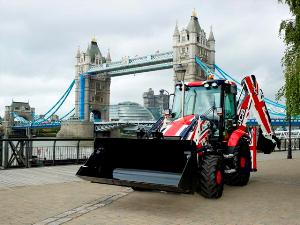Jul 12 2010
British manufacturer JCB today took the wraps off its latest digger in patriotic style after a multi-million pound investment to develop a machine which will cut customers’ fuel costs by up to 16 per cent.
The backhoe loader - the construction industry’s term for a machine with a rear excavating arm and front shovel - was pioneered by JCB’s founder Joseph Cyril Bamford in 1953. Today JCB is the world’s biggest producer of these products with a market share of 41%.
JCB has now embarked on a £20 million investment in a new generation of this most iconic of British products. The first of the new range of the British-built diggers rolled off the company’s Staffordshire production line in Union Jack colours and embarked on a tour of famous London landmarks to celebrate its launch and the company’s approaching 65th anniversary in October.
 British-built digger
British-built digger
The 3CX and 4CX models, which have a starting price of £40,000, go into full production next month and will offer a machine which uses up to 16 per cent less fuel compared to its predecessor – saving customers using the digger for an average 1,250 hours a year more than £1,000 on fuel costs.
And in a move that will keep Britain’s army of digger drivers happy, JCB now offers an in-cab drinks machine able to make tea, coffee and soup for those cold winter mornings on the building site.
JCB Chairman Sir Anthony Bamford said: “JCB’s backhoe loader has been a British manufacturing and export success for nearly 60 years and our Union Jack backhoe is a celebration of that and the fact we’ve sold more than 450,000 backhoes in over 140 different countries over that time. Our investment in this latest generation of machines will build on that success and help our customers save money on fuel during these tough economic times. JCB has always flown the flag for British manufacturing and we will continue to do that as this country is a fantastic place to do business.”
The fuel savings are derived largely though the introduction of a new hydraulic system which utilises three hydraulic pumps instead of two, providing the same hydraulic output but at lower engine speeds. The introduction of power brakes also contributes to the fuel savings.
Source: http://www.jcb.com/